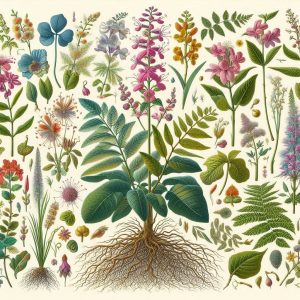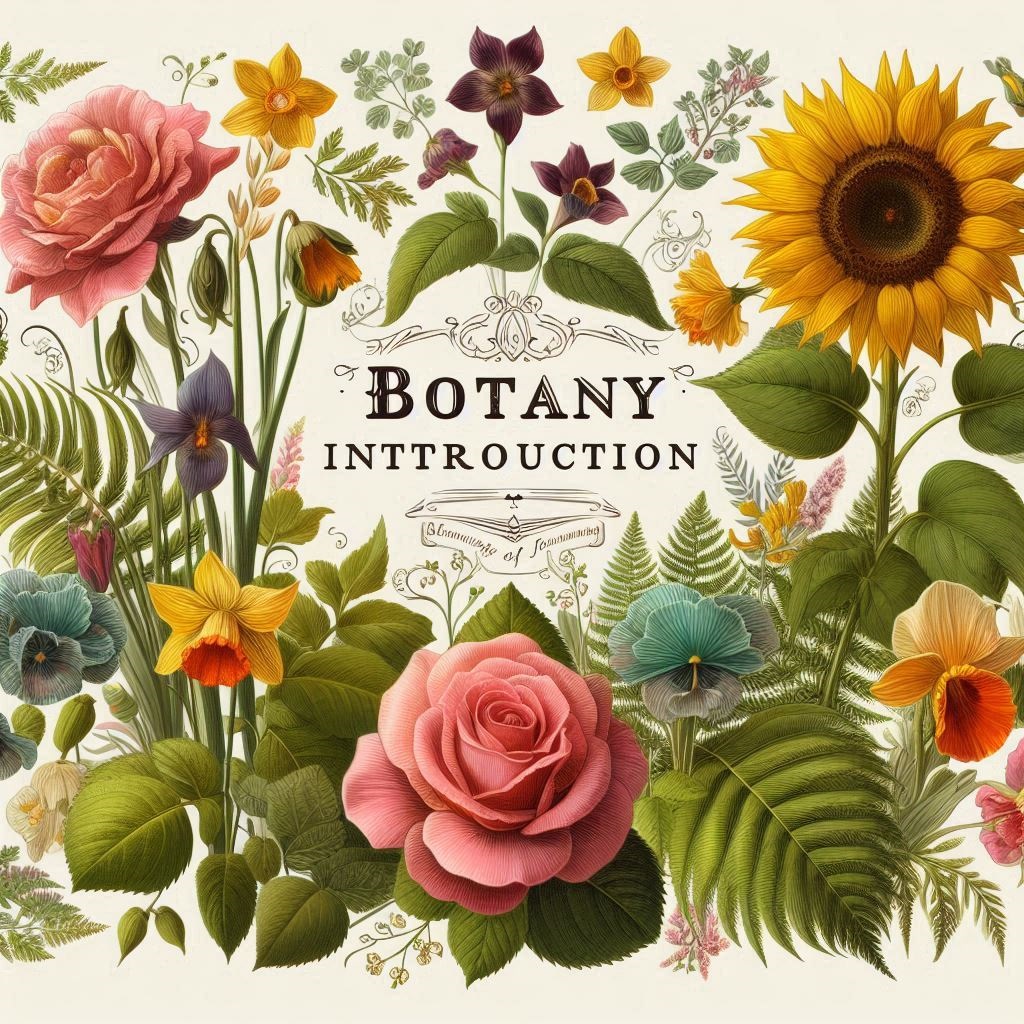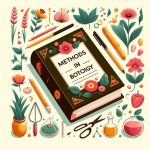The Introduction of Botany
Botany is the scientific study of plants, including their structure, properties, and biochemical processes. It encompasses various aspects of plant life, from the cellular level to the ecosystem. As a major branch of biology, botany is crucial for understanding plant growth, reproduction, and environmental interactions. This article overviews botany, including its importance, branches, and applications.
What is Botany?
Botany is derived from the Greek word botane, meaning “plant.” It is a field that explores the complex biology of plants, including their taxonomy, physiology, ecology, and evolution. Botanists study various plant types, from the smallest algae to the largest trees, and investigate their role in the environment and their significance to humans.
branches of Botany

Branches of Botany
Botany, the scientific study of plants, is a vast field encompassing various specialized branches. Each branch focuses on different aspects of plant life, contributing to our overall understanding of plant biology, ecology, and applications. Here, we explore the major branches of botany, their focuses, and their significance.
Botany is divided into several branches, each focusing on different aspects of plant science:
- Plant Anatomy: Studies the internal structure of plants, including tissues and organs.
- Plant Physiology: Examines the functions and processes of plants, such as photosynthesis and respiration.
- Plant Ecology: Focuses on plant interactions with their environment and other organisms.
- Plant Taxonomy: Involves the classification and naming of plants.
- Plant Genetics: Explores the genetic makeup and inheritance in plants.
1. Plant Anatomy
Plant anatomy studies the internal structure of plants, including tissues and organs. This branch investigates how plants are organized at the microscopic and macroscopic levels, such as cells, tissues, and organ systems. Understanding plant anatomy is crucial for improving crop yield and developing disease-resistant plant varieties.
Read more about Plant Anatomy at NCBI
2. Plant Physiology
Plant physiology focuses on the functions and processes of plants, including photosynthesis, respiration, and nutrient uptake. This branch explores how plants grow, develop, and respond to environmental stimuli. Insights from plant physiology are essential for enhancing agricultural practices and understanding plant adaptation mechanisms.
Explore Plant Physiology at Frontiers in Plant Science
3. Plant Ecology
Plant ecology examines how plants interact with their environment and other organisms. This branch studies plant distribution, community dynamics, and ecosystem functions. Plant ecologists assess the impact of environmental changes on plant communities and work on conservation strategies to protect biodiversity.
Learn more about Plant Ecology at JSTOR
4. Plant Taxonomy
Plant taxonomy involves the classification, identification, and naming of plants. This branch organizes plant species into categories based on their similarities and evolutionary relationships. Plant taxonomists create detailed classifications that help in the identification and study of plant diversity.
Discover Plant Taxonomy at Britannica
5. Plant Genetics
Plant genetics focuses on the hereditary aspects of plants, including the study of genes, genetic variation, and inheritance patterns. This branch explores how genetic information is passed from one generation to the next and how genetic diversity influences plant traits. Research in plant genetics is vital for crop improvement and genetic engineering.
Read about Plant Genetics at Nature
6. Ethnobotany
Ethnobotany studies the relationship between plants and human cultures. This branch investigates how different societies use plants for food, medicine, and cultural practices. Ethnobotanists document traditional knowledge and contribute to sustainable plant use and conservation efforts.
Explore Ethnobotany at ScienceDirect
Table: Major Branches of Botany
| Branch | Focus | Applications |
|---|---|---|
| Plant Anatomy | Internal structure of plants | Crop improvement, disease resistance |
| Plant Physiology | Functions and processes of plants | Agricultural practices, plant adaptation |
| Plant Ecology | Plant-environment interactions | Conservation, biodiversity protection |
| Plant Taxonomy | Classification and naming | Species identification, biodiversity studies |
| Plant Genetics | Genetic makeup and inheritance | Genetic modification, crop enhancement |
| Ethnobotany | Plant use in human cultures | Sustainable use, cultural preservation |
Further Reading and Resources
For additional information on the branches of botany, you may find the following resources useful:
- Botanical Society of America
- Royal Botanic Gardens, Kew
- NCBI: Introduction to Botany
- Britannica: Botany Overview
Importance of Botany
Botany plays a vital role in various aspects of human life and the environment:
- Food Production: Understanding plant biology is essential for agriculture and crop improvement.
- Medicine: Many pharmaceuticals are derived from plant compounds.
- Environmental Conservation: Knowledge of plant ecology helps in conserving natural habitats and biodiversity.
- Climate Change: Plants play a critical role in carbon sequestration and climate regulation.
Botany, the scientific study of plants, is a critical field of biology that holds significant importance across various aspects of life on Earth. Understanding plants and their processes not only enhances our knowledge of the natural world but also has practical implications for agriculture, medicine, and environmental conservation. Here’s an exploration of why botany is so vital.
1. Environmental Conservation
Plants play a crucial role in maintaining the ecological balance of our planet. They produce oxygen, absorb carbon dioxide, and provide habitat for numerous species. Botanical research helps us understand plant ecosystems and their responses to environmental changes, which is essential for developing conservation strategies and protecting biodiversity.
Learn more about the importance of plant conservation at Nature
2. Agriculture and Food Security
Botany directly impacts agriculture by improving crop yield and resistance to pests and diseases. Research in plant genetics and physiology contributes to the development of high-yielding and nutritious crops. Understanding plant growth and development helps in managing soil health and water resources, which are critical for ensuring global food security.
Explore the role of plant breeding in agriculture at FAO
3. Medicine and Pharmaceuticals
Many medicinal compounds are derived from plants. Botanical research helps in identifying and developing new drugs and therapies. Plants are a source of various bioactive compounds used in traditional and modern medicine. Understanding plant chemistry and biology is essential for discovering and utilizing these compounds effectively.
Read about medicinal plants and their uses at NCBI
4. Climate Change Mitigation
Plants play a pivotal role in mitigating climate change by sequestering carbon dioxide through photosynthesis. Botanical studies help us understand how different plant species adapt to changing climates and how they can be utilized in strategies to combat global warming. This research is crucial for developing sustainable practices and policies to address climate change.
Discover the role of plants in climate change mitigation at IPCC
5. Economic Impact
The botanical sector has significant economic implications. Industries related to agriculture, pharmaceuticals, and horticulture rely on botanical research and knowledge. Plants contribute to various economic activities, including the production of food, textiles, and ornamental plants. Understanding plant biology can lead to innovations and economic opportunities in these industries.
Read about the economic impact of botany at Business Insider
Table: Key Aspects of Botany’s Importance
| Aspect | Importance | Relevant Link |
|---|---|---|
| Environmental Conservation | Maintains ecological balance, provides oxygen, and supports biodiversity | Nature |
| Agriculture and Food Security | Improves crop yield, resistance, and ensures food security | FAO |
| Medicine and Pharmaceuticals | Source of medicinal compounds and drug development | NCBI |
| Climate Change Mitigation | Sequesters carbon, adapts to climate change, and supports sustainability | IPCC |
| Economic Impact | Drives industries related to agriculture, pharmaceuticals, and horticulture | Business Insider |
Further Reading and Resources
- Botanical Society of America
- Royal Botanic Gardens, Kew
- NCBI: Introduction to Botany
- Britannica: Botany Overview
Applications of Botany
Botany has numerous applications that impact everyday life and industry:
- Agriculture: Botany contributes to crop breeding, pest management, and sustainable farming practices.
- Pharmacology: Botanists research plant-based medicines and develop new drugs.
- Horticulture: Involves the cultivation of plants for decorative and landscape purposes.
- Forestry: The study of trees and forests for sustainable management and conservation.
Botany, the scientific study of plants, has a multitude of practical applications that significantly impact various fields. From agriculture to medicine, botany’s applications help address global challenges and improve our quality of life. Here’s an in-depth look at how botany is applied across different sectors.
1. Agriculture and Crop Improvement
Botany plays a critical role in agriculture by enhancing crop production and ensuring food security. Through plant breeding and genetic modification, scientists develop crop varieties that are more resistant to pests, diseases, and environmental stresses. Understanding plant physiology and genetics helps optimize growth conditions and improve yield.
Learn more about plant breeding and crop improvement at Agriculture and Agri-Food Canada
2. Medicine and Pharmaceuticals
Many pharmaceuticals are derived from plant sources. Botanical research aids in discovering new medicinal compounds and developing treatments for various diseases. Plants are used to produce antibiotics, analgesics, and anti-cancer drugs. The study of plant compounds contributes to the advancement of modern medicine.
Explore the role of medicinal plants at NCBI
3. Environmental Conservation
Botany is essential for environmental conservation efforts. Understanding plant ecology and diversity helps in the restoration of degraded habitats and the preservation of endangered species. Botanical studies inform conservation strategies and policies aimed at protecting plant species and maintaining ecosystem health.
Read about biodiversity conservation at Conservation International
4. Horticulture and Landscaping
In horticulture and landscaping, botany is applied to design aesthetically pleasing and functional outdoor spaces. Knowledge of plant species, soil types, and environmental conditions is used to create gardens, parks, and green spaces that enhance urban environments and improve human well-being.
Discover horticulture resources at University of Maryland Extension
5. Biofuels and Renewable Energy
Botany contributes to the development of biofuels and renewable energy sources. Research in plant biology helps in identifying plant species that can be used to produce bioethanol, biodiesel, and other renewable fuels. This research supports the transition to sustainable energy systems and reduces dependence on fossil fuels.
Learn about bioenergy at the U.S. Department of Energy
Table: Major Applications of Botany
| Application | Description | Relevant Link |
|---|---|---|
| Agriculture and Crop Improvement | Enhances crop yield and resistance through breeding and genetic modification. | Agriculture and Agri-Food Canada |
| Medicine and Pharmaceuticals | Discovers and develops new medicinal compounds and drugs from plants. | NCBI |
| Environmental Conservation | Supports conservation efforts and habitat restoration to protect plant species and ecosystems. | Conservation International |
| Horticulture and Landscaping | Applies plant knowledge to create functional and aesthetic outdoor spaces. | University of Maryland Extension |
| Biofuels and Renewable Energy | Develops renewable energy sources from plant materials to reduce fossil fuel dependence. | U.S. Department of Energy |
Table: Key Areas in Botany
| Branch | Focus | Applications |
|---|---|---|
| Plant Anatomy | Internal structure of plants | Improving crop yield and disease resistance |
| Plant Physiology | Plant functions and processes | Enhancing photosynthesis and growth |
| Plant Ecology | Plant-environment interactions | Conservation and habitat management |
| Plant Taxonomy | Classification and naming | Identification and cataloging of species |
| Plant Genetics | Genetic makeup and inheritance | Crop improvement and genetic modification |
Further Reading and Resources
For more information on botany, check out these resources:
- Botanical Society of America
- NCBI: Introduction to Botany
- Royal Botanic Gardens, Kew
- Britannica: Botany Overview
Frequently Asked Questions (FAQs)
1. What is botany?
Botany is the scientific study of plants, including their structure, properties, and biochemical processes. It covers various aspects of plant life, from the molecular level to whole ecosystems.
2. Why is botany important?
Botany is crucial for several reasons, including improving agricultural practices, discovering medicinal plants, conserving biodiversity, and understanding ecological relationships. It plays a key role in food security, health care, and environmental sustainability.
3. What are the main branches of botany?
The main branches of botany include plant physiology, plant anatomy, plant taxonomy, plant ecology, and plant genetics. Each branch focuses on different aspects of plant life and their interactions with the environment.
4. How can I study botany?
Botany can be studied through academic programs at universities and colleges, online courses, and hands-on fieldwork. Many institutions offer specialized degrees and research opportunities in botany.
5. What career opportunities are available in botany?
Careers in botany include roles in research, teaching, environmental consulting, agriculture, horticulture, and conservation. Botanists can work in academia, government agencies, non-profit organizations, and private industry.
Disclaimers
The information provided in this article is for educational and informational purposes only. It is not intended as professional advice or a substitute for consulting with qualified experts in the field of botany. Always seek the guidance of a professional for specific questions or concerns.
While we strive to provide accurate and up-to-date information, the field of botany is constantly evolving. Some information may change over time as new research and discoveries are made. We recommend checking reputable sources and recent publications for the latest updates.
Cautions
1. Handling Plants Safely
When handling plants, especially unfamiliar or potentially toxic species, exercise caution. Some plants can cause allergic reactions, skin irritation, or other health issues. Wear gloves and protective clothing as necessary, and avoid ingestion of unknown plant material.
2. Environmental Impact
Botanical activities, such as collecting plant specimens or altering habitats, should be conducted responsibly to avoid negatively impacting ecosystems. Follow ethical guidelines and local regulations to ensure conservation and sustainability.
3. Accurate Identification
Proper identification of plant species is essential for research and practical applications. Misidentification can lead to incorrect conclusions or harmful practices. Use reliable resources and consult experts when identifying plants.
4. Research Limitations
Botany research can have limitations due to various factors, including sample size, experimental conditions, and the complexity of plant systems. Be aware of these limitations when interpreting research findings and consider multiple sources of information.



